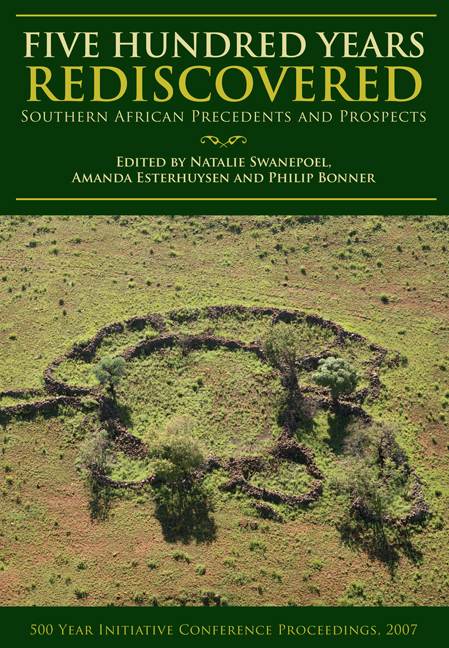Book contents
- Frontmatter
- Contents
- Preface
- 1 Introduction
- Section 1 Disciplinary Identities: Methodological Considerations
- 2 Historical archaeologies of southern Africa: precedents and prospects
- 3 South Africa in Africa more than five hundred years ago: some questions
- 4 Towards an outline of the oral geography, historical identity and political economy of the Late Precolonial Tswana in the Rustenburg region
- 5 Metals beyond frontiers: exploring the production, distribution and use of metals in the Free State grasslands, South Africa
- 6 deTuin, a 19th-century mission station in the Northern Cape
- 7 Reinterpreting the origins of Dzata: archaeology and legends
- Section 2 Material Identities
- Section 3 ‘Troubled Times’: Warfare, State Formation and Migration in the Interior
- List of contributors
- Index
3 - South Africa in Africa more than five hundred years ago: some questions
from Section 1 - Disciplinary Identities: Methodological Considerations
Published online by Cambridge University Press: 30 May 2019
- Frontmatter
- Contents
- Preface
- 1 Introduction
- Section 1 Disciplinary Identities: Methodological Considerations
- 2 Historical archaeologies of southern Africa: precedents and prospects
- 3 South Africa in Africa more than five hundred years ago: some questions
- 4 Towards an outline of the oral geography, historical identity and political economy of the Late Precolonial Tswana in the Rustenburg region
- 5 Metals beyond frontiers: exploring the production, distribution and use of metals in the Free State grasslands, South Africa
- 6 deTuin, a 19th-century mission station in the Northern Cape
- 7 Reinterpreting the origins of Dzata: archaeology and legends
- Section 2 Material Identities
- Section 3 ‘Troubled Times’: Warfare, State Formation and Migration in the Interior
- List of contributors
- Index
Summary
Introduction
Before the spread of English language and cultural hegemony and resistance to it, there was Afrikaans-Dutch hegemony and resistance to it, and before that there were the post-1500 hegemonies of and resistances to Nguni and Sotho-Tswana. Nomenclature is always a problem. But the ‘true’ Nguni can be clearly identified with certain clans (including Zulu) among the larger Nguni-speaking group of South-East Bantu speakers. Similarly, there are dominant ancestral lineages among Sotho-Tswana speakers, namely Rolong and Kwena and Kgatla, who can with less certainty be referred as ‘true’ Tswana. The term ‘Tswana’ as self-identity appears to date from only c. 1800 (e.g. Barrow 1806) in answer to questions from foreigners in the south. ‘Sotho’ has been more loosely applied to the whole linguistic group including Tswana, Pedi, and even Khalagari.
The immediate stimulus of this chapter was a visit to the brilliant new museum of the Origins Centre on Wits campus. One of the last displays is an animated image of two maps, which also appear as figures in Tom Huffman's chapter in Himla Soodyall's The Prehistory of Africa: Tracing the Lineage of Modern Man (2006: 103 & 107): ‘Spread of Eastern Bantu speakers during the Early Iron Age’ and ‘Late Iron Age movements of Nguni and Sotho- Tswana’.
This chapter is an attempt to get to grips with the prehistory of Nguni and Sotho-Tswana before 1500. It ventures beyond conventional history into heuristic models of the past – models that help us to understand general patterns of development, in order that we may contextualise and further investigate the myriad of details, and then also question the very models themselves. These models are largely drawn from two disciplines, archaeology and historical linguistics – the relationship between which is controversial. The debate over ‘talking pots’, i.e. whether language groups can be equated with pottery (ceramic) groups, dates back at least to 1966 – when Roland Oliver presented his synthesis of Malcolm Guthrie's Bantu linguistic map with 52 new radiocarbon dates for pottery north of the Limpopo (Oliver 1966).
- Type
- Chapter
- Information
- Five Hundred Years RediscoveredSouthern African precedents and prospects, pp. 41 - 54Publisher: Wits University PressPrint publication year: 2008

